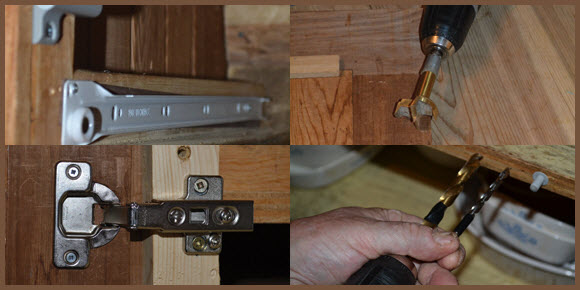Adding soft close hardware to kitchen and bathroom cabinets can be easy to challenging, depending on existing hinges or drawer slides.
Cabinets with European-style hinges and drawer slides without a built-in soft close hardware only require a screwdriver and cordless drill to upgrade them. However, old cabinets with mortised butt hinges or face-mounted decorative hinges need more work to adapt to soft close, as do drawers with wood slides.
Let’s start by assuming your cabinets have European hinges and slides without built-in soft close mechanisms.
To this end, I experimented with three soft close hardware options priced from very expensive to inexpensive.
The costliest choice was a pair of European-style hinges with a built-in soft close mechanism. Fortunately, the hinges were the same size as the existing ones on my cabinet doors, so I was able to unscrew the old pair and replace them with the new ones without alterations. The hinges successfully damped the noise of the closing doors — my only complaint was the price, almost $34 per pair. As my cabinet required two pair, the cost was $68 to upgrade to soft close. Imagine the cost of installing these hinges on multiple doors.
I next experimented with a Blum Blumotion door damper that was simple to mount onto the inside of my cabinet with two screws. The damper consisted of an adjustable (length of protrusion) piston that extended from a metal cylinder. The piston was designed to contact the door as it was closed. The instructions said to screw the mechanism to the upper corner of the cabinet closest to the hinges.
I had two problems with this gizmo: First, try as I might, I could not get it to function properly. Even with the piston set at the least amount of protrusion, the hinges did not exert sufficient compression strength to completely depress the piston, as a result, the door remained ajar. Second, at $12 each, these gadgets are less expensive than soft close hinges, but they are still pricey compared to the third option I investigated.
I really liked option three because it was reasonably priced and could be adapted for use on doors and drawers. The simple bumper was comprised of a polymer cylinder and mounting plate with a removable spring-loaded piston. The cost was about $5 per damper.
(If you read my July 7 column, I showed how to retrofit a wood slide drawer with modern metal glides. I used glides without a built-in damper because they were significantly less pricey at $12 per drawer than their soft close counterparts, up to $60 per drawer.)
Using a $5 bumper, I converted my drawer to soft close by screwing the damper onto the side of the cabinet’s interior, so that its piston engaged with the overhang on one side of the drawer’s face. The piston allowed the drawer to close softly and completely.
Versatile $5 bumpers can also be used to dampen cabinet doors easily and effectively using two methods:
1. Screw the entire assembly to the top interior of a cabinet near the hinge so the piston protrudes. The door will close silently.
2. Remove the piston from the cylinder by pulling gently outward. Drill a 3/8-inch hole into an edge of the cabinet to the proper depth and then push the piston into the hole. A collar prevents the mechanism from sliding all the way into the hole if it is too deep; moreover, the piston is manufactured to friction fit into a 3/8-inch hole without the need for adhesive.
For my money — most of which I like to keep in the bank — I recommend the inexpensive polymer bumpers to anyone who is thinking about retrofitting their cabinet doors and drawers to soft close. These mechanisms are well made and should last a lifetime, without bankrupting you.
Finally, for those who have cabinet doors with decorative face or mortised butt hinges, it is possible to convert them to European-style hinges. See the attached photos that show how I replaced the face hinges on my cabinet doors with European ones.



